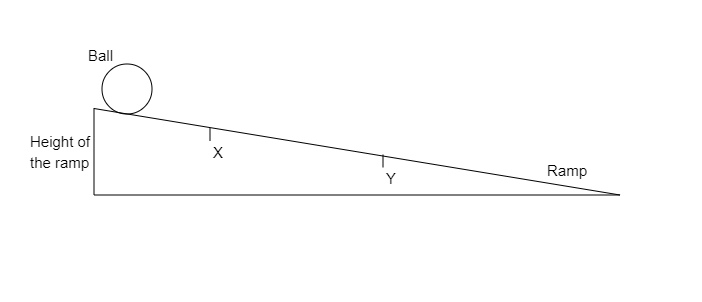
A ball rolls down a ramp. The time it takes to move from $X$ to $Y$ is measured. Which other quantity must be measured in order to calculate the average speed of the ball between point $X$ and point $Y$?

(A) Angle of the slope.
(B) the diameter of the ball.
(C) distance between $X$and $Y$.
(D) height of the ramp.

Answer
574.2k+ views
Hint: The length of the ramp affects the average speed of the ball that rolls down the ramp. The ball that displaces from the point $X$ to the point $Y$ does a type of motion called the Rolling. Rolling can be explained as the combination of translational motion and rotational motion with reference to the surface in such a way the conditions that exit are ideal.
Complete step by step answer:
The reason for finding the average speed is that it is very much important to understand the momentum at which the journey takes place. Along the journey, the speed of the object varies. Due to such cases, it is very much to find the average speed in order to judge the rate of the journey. The average speed of the ball can be calculated by dividing the total amount of distance that the ball has to cover by the total amount of time the ball has taken to cover that particular distance.
$s = \dfrac{d}{t}$
Where,
$s$ denotes the average speed of the ball,
$d$ denotes the distance traveled by the ball (in this case from point $X$ to $Y$),
$t$ denotes the time taken.
Therefore, to find the average speed between the point $X$ and $Y$, we must find the distance between the point $X$ and $Y$.
Hence, option (C) is the correct answer.
Note:
The force that causes the ball to roll down the ramp is the gravitational force and frictional force. These two forces are part of the fundamental forces of nature. The SI unit of speed is $m{s^{ - 1}}$,the SI unit of distance is $m$and the SI unit of time is $s$. The height of the ramp can also play a vital role in the speed of the ball. The simple change in the height of the ramp can drastically change the speed of the object.
Complete step by step answer:
The reason for finding the average speed is that it is very much important to understand the momentum at which the journey takes place. Along the journey, the speed of the object varies. Due to such cases, it is very much to find the average speed in order to judge the rate of the journey. The average speed of the ball can be calculated by dividing the total amount of distance that the ball has to cover by the total amount of time the ball has taken to cover that particular distance.
$s = \dfrac{d}{t}$
Where,
$s$ denotes the average speed of the ball,
$d$ denotes the distance traveled by the ball (in this case from point $X$ to $Y$),
$t$ denotes the time taken.
Therefore, to find the average speed between the point $X$ and $Y$, we must find the distance between the point $X$ and $Y$.
Hence, option (C) is the correct answer.
Note:
The force that causes the ball to roll down the ramp is the gravitational force and frictional force. These two forces are part of the fundamental forces of nature. The SI unit of speed is $m{s^{ - 1}}$,the SI unit of distance is $m$and the SI unit of time is $s$. The height of the ramp can also play a vital role in the speed of the ball. The simple change in the height of the ramp can drastically change the speed of the object.
Recently Updated Pages
Master Class 11 Economics: Engaging Questions & Answers for Success

Master Class 11 English: Engaging Questions & Answers for Success

Master Class 11 Social Science: Engaging Questions & Answers for Success

Master Class 11 Biology: Engaging Questions & Answers for Success

Class 11 Question and Answer - Your Ultimate Solutions Guide

Master Class 11 Business Studies: Engaging Questions & Answers for Success

Trending doubts
10 examples of friction in our daily life

One Metric ton is equal to kg A 10000 B 1000 C 100 class 11 physics CBSE

Difference Between Prokaryotic Cells and Eukaryotic Cells

1 Quintal is equal to a 110 kg b 10 kg c 100kg d 1000 class 11 physics CBSE

State the laws of reflection of light

Explain zero factorial class 11 maths CBSE




